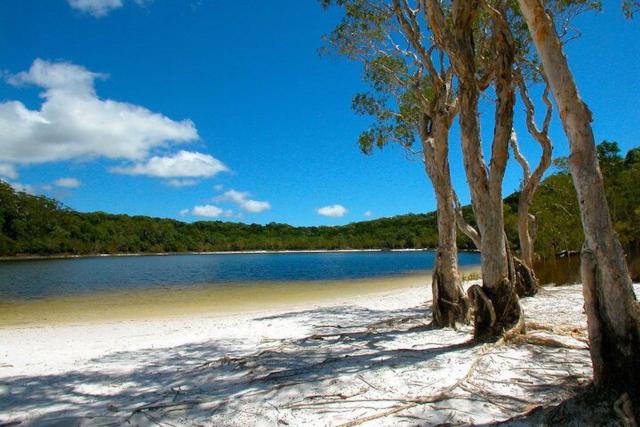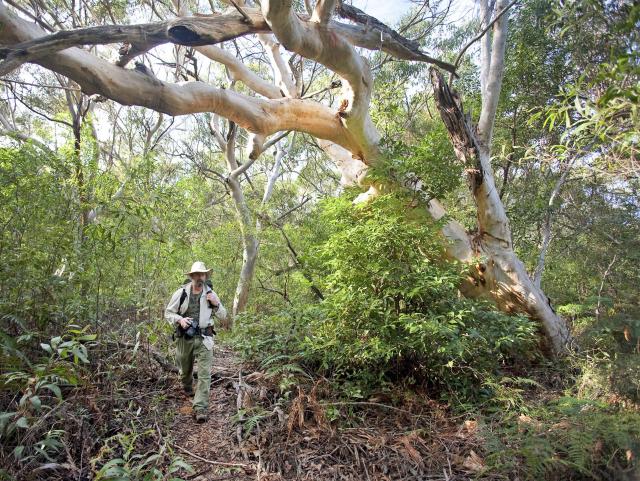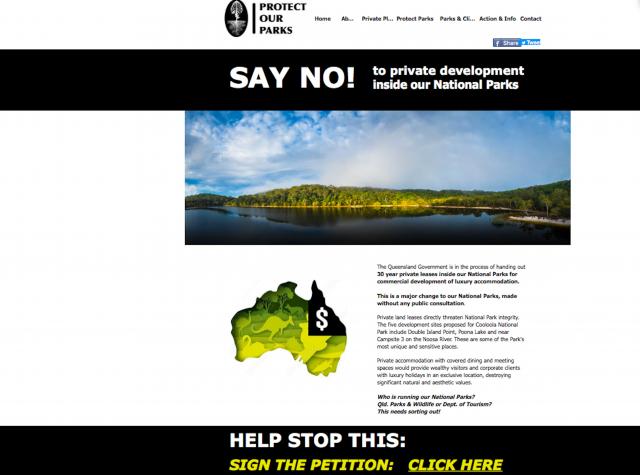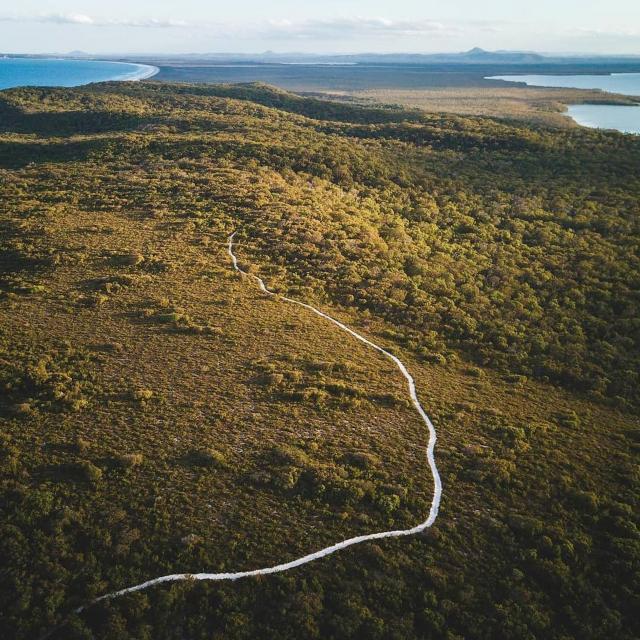The perched lake of Poona is set to become the decisive battleground as conservation and community groups push hard to stop or at least modify the commercial Cooloola Great Walk.
This magnificent lake at the northern end of the Cooloola Recreation area, hemmed by a white sand beach of cultural significance to the Traditional Owners as a one-time Kabi Kabi birthing site, and part of the Noosa River catchment, is currently slated to be one of five commercial glamping sites to be developed by CABN Pty Ltd, a South Australian-based eco-tourism operator.
Most concerning in the eyes of its opponents, Poona is one of two much bigger sites on the proposed commercial walk (the other being Double Island Point) that will host 10 large cabins and a communal dining area over half a hectare.
The entire CABN proposal has been green-lighted by the Federal Environment Protection and Biodiversity Conservation Act (EPBC) after an assessment last year of its Matters of National Environmental Significance, and the Federal Environment Minister advising that the project was not considered a “controlled action” under the Act, meaning that no further Commonwealth assessment was required.
While the project still has several state-based approvals to get through in a pathway almost as tricky as parts of the walk itself, Noosa/Wide Bay Greens spokesperson Rhonda Prescott was the first local environmentalist to call out the Queensland government for deceiving the public about its scope.
Last year she told Noosa Today: “Initial publicity about the Cooloola Great Walk Ecotourism Project suggested tiny glamping-style tents complementing the Great Walk. Impacts on the environment, we were assured, would be minimal.
“Now that the community consultation and information phase of the project has ended, it’s clear that the reality will be quite different. The consultation exercise has been inadequate, with many unanswered questions.
“Basic information is lacking on crucial issues – the number of vehicle movements in areas which now see very few, the amount of revenue which flows back to the State Government, the impact of the proposal on current low-impact visitors, and the possibility of a massive expansion of the project in the future.”
This week Ms Prescott reiterated her fears about the Great Walk: “Firstly, the very name ecotourism implies ecological sensitivity but is often used to greenwash developments that are in fact ecologically damaging. I am sure that the environmentalists that you are contacting will fill you in on their concerns about the construction of 10 large cabins on a hillside just 60 metres from Lake Poona, construction of an access road and other environmental impacts.
“Secondly, the fact that there seems to be conflict between Queensland Environment Minister Meaghan Scanlon, who actually does seem to have a genuine interest in preserving our natural environment, and pro-development Tourism Minister Stirling Hinchliffe. It was interesting to learn that Hinchliffe was a lobbyist for the Rainbow Shores Stage Two development at Inskip Point.
“A third controversial aspect is the involvement [in the Great Walk project] of Brian Warner, a director of the Kabi Kabi Peoples Aboriginal Corporation and the inference that this body is speaking for and representing all Kabi Kabi people … suffice to say that there does not appear to be unanimous support.“
Later last year, as details about the campsite locations began to emerge, veteran eco-crusader Greg Wood, a resident of Rainbow Beach at the edge of Cooloola Recreation Area for 40 years, saw that a call to arms was becoming necessary, first through local pamphleteering and then with an ambitious website called Protect Our Parks, which expresses the broad view that private enterprise should not be allowed on our national parks and demonstrates the point through closer examination of what is now happening in our own backyard.
To understand the fiery passion that Greg brings to this crusade, you need to know a little of his background. Originally from Adelaide, he was making his way to Cairns with a mate in the early ‘80s when he dropped into Rainbow Beach, got drunk in the pub and slept on the beach.
He recalls: “My first morning waking up in the sand dunes with a hangover I looked out at the ocean and about 20 metres out was a whale and its calf. Then I looked down towards Double Island Point and it was just stunning. I ended up spending three years at DI, working intermittently on upgrading the lighthouse. You could camp there legally in those days.”
Greg fell in love with a town built on sand mining, and was soon campaigning against it.
He says: “I was developing an environmental consciousness back then, but it really kicked in when I got married and we went down south and started a recycling business on the Northern Rivers. We came back to the Sunshine Coast in ‘95 and were horrified at the extent of the development so we kept going back to Rainbow, and it was like we never left.”
But change was on the horizon, and Greg became part of a small core of residents opposing the proposed developments in Rainbow and Tin Can Bay that would bring 30,000 residents into their little paradise. Now, more than a quarter-century later, he’s back in the trenches.
He says: “In my semi-retirement I started working on Cooloola Coast projects and a community website and that led to Protect Our Parks. The notion of private development on public land really rankled with me, but you wouldn’t believe the arguments that I had over whether we should talk about anything beyond our particular park. It occurred to me that we needed people to support us from beyond our region, beyond the state, so we’ve tried to achieve a balance on the site.
“One of the things I find very concerning about the Great Walk project is that they seem to have taken commercial in confidence far beyond any normal constructs. It’s become a smokescreen. I understand that some of the negotiations are delicate and need to be kept confidential, but people need to be given a clearer idea of what is going on.
“Let’s put aside the issue of private development in national parks for a moment and say we’re going to allow that. Wouldn’t you at least then keep the sites away from the fragile ecosystems of Poona and the Noosa River?”
On the Protect Our Parks website you can find a healthy list of supporter groups, including Noosa Integrated Catchment Association (NICA) and the Mary River Catchment Committee, both of which have expressed great concern over the campsites proposed for Poona and on the Noosa River.
Perhaps less well known on the list is a group called Keep Cooloola Cool, the brainchild of Noosa-based architect Matt Noffke and a few friends, colleagues and family. But don’t let its size fool you. KCC means business and its founder is passionate about protecting the park. A petition he organised and which closed last month received more than 5000 signatures.
He says: “We set up Keep Cooloola Cool because no one else was prepared to talk about the issues. No one seemed to know what was going on, even people like us. We have a nature refuge that adjoins the park at Elanda Point, and to be honest we were somewhat comfortable with the idea of simple glamping tents going in, but two years ago we didn’t know what we know now.
“If they’d done a proper consultation we wouldn’t have ended up where we are at. The community would be seeing more benefit, the Kabi Kabi would benefit more. We still haven’t seen plans of what they propose to build on these sites, including Poona Lake. Even the descriptions in the documentation are misleading and contradictory.
“We know that plans exist because they’ve been through EPBC, and they should be in the public domain considering the park is a public asset.”
Over the Christmas break, Matt and his architectural intern Laura created an alternative business proposal focussing on an Indigenous interpretive centre in an existing building at Elanda Point from which tours could radiate out.
Says Matt: “That was just one idea of many which the Kabi Kabi could develop and help prosper, and it doesn’t need a third party commercial operator. Keep Cooloola Cool will keep fighting on the issues. We’re not just a pop-up part of the Protect Our Parks petition campaign.
“We think the proposal is so inappropriate that we’ll fight, and we’ve been working in the background for some time. We had a community day at Boreen Point where we presented the background to the proposal more than five months ago. We’ll continue our efforts to create greater awareness of what is really going on in Cooloola.”
At the time of writing, the Protect Our Parks petition to Environment Minister Meaghan Scanlon had more than 2500 signatures and was growing daily.
Meanwhile, seasoned campaigner Greg Wood was continuing to lobby politicians and media.
When Noosa Today spoke to him last month he had just returned from guiding Brisbane News reporter Tony Moore around Poona Lake. Moore was so impressed by its beauty, fragility and significance that he launched an ongoing campaign in his paper.
On 15 February he reported that Minister Scanlon said she had not been briefed on ecological concerns raised by her department in the March 2021 Cooloola Great Walk Ecotourism Trail Proposed Site Selection report.
“After meetings with her department on the controversy, Ms Scanlon in the afternoon said she had requested more details,” Moore wrote.
He quoted the Minister as saying: “I have today been briefed more broadly on the Cooloola proposal, but I have asked my department to brief me in detail on the options around the site selection. Ultimately we want to get the balance right, selecting sites which protect Cooloola’s world-class environment, but in ways the world wants to experience.”
Read more about the Cooloola campaign at protectparks.net and keep-cooloola-cool.org










